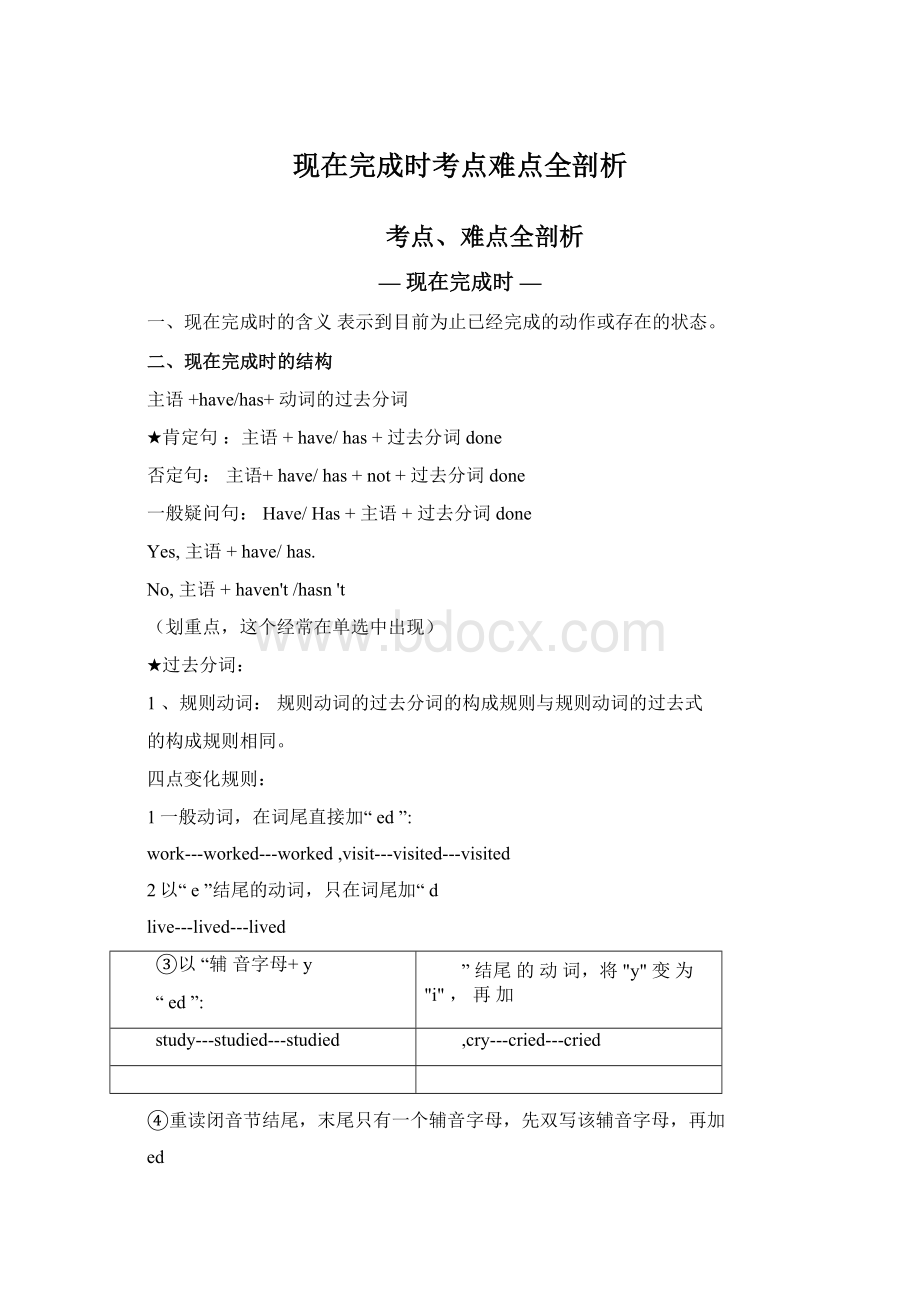现在完成时考点难点全剖析.docx
《现在完成时考点难点全剖析.docx》由会员分享,可在线阅读,更多相关《现在完成时考点难点全剖析.docx(10页珍藏版)》请在冰豆网上搜索。

现在完成时考点难点全剖析
考点、难点全剖析
—现在完成时—
一、现在完成时的含义表示到目前为止已经完成的动作或存在的状态。
二、现在完成时的结构
主语+have/has+动词的过去分词
★肯定句:
主语+have/has+过去分词done
否定句:
主语+have/has+not+过去分词done
一般疑问句:
Have/Has+主语+过去分词done
Yes,主语+have/has.
No,主语+haven't/hasn't
(划重点,这个经常在单选中出现)
★过去分词:
1、规则动词:
规则动词的过去分词的构成规则与规则动词的过去式
的构成规则相同。
四点变化规则:
1一般动词,在词尾直接加“ed”:
work---worked---worked,visit---visited---visited
2以“e”结尾的动词,只在词尾加“d
live---lived---lived
③以“辅音字母+y
“ed”:
”结尾的动词,将"y"变为"i",再加
study---studied---studied
cry---cried---cried
④重读闭音节结尾,末尾只有一个辅音字母,先双写该辅音字母,再加
ed
stop---stopped---stoppeddrop---dropped--dropped
2.不规则动词
AAA型
burstburstburst
hurthurthurt
letlet
let
cutcutcut
it
costcostcosthithith
putputput
setsetsetshutshut
原形和过去分词
shut
spreadspreadspreadreadreadread(read
发音为/ri:
d/,过去式发音为/red/)
AAB型
beatbeatbeaten
ABA
becomebecamebecomerunranrun
comecamecome
ABB型
bringbroughtbroughtuiltbuilt
burnburntburntgdug
feelfeltfeltdfoundfoundhearheardheardkept
laylaidlaidlost
makemademadesold
shootshotshotstoodstood
sweepsweptsweptoldtold
thinkthoughtthought
ABC型
buyboughtboughtbuildb
catchcaughtcaughtdigdu
fightfoughtfoughtfin
holdheldheldkeepkept
leadledledloselost
meetmetmetsellsold
sitsatsatstand
teachtaughttaughttellt
winwonwon
beginbeganbegun
blowblewblown
breakb
rokebroken
rovedriven
wrotewritten
ivegavegiven
idden
shookshaken
swamswum
throwthrewthrown
理本或者笔记本上!
(注意哦,一定要记在一起啊,记得在笔记本上预留他们的专属位置哟)
三、常见用法(重点)
1.表示过去发生或已经完成的动作对现在造成的影响或结果,
有以下四大标志词:
1already,just和yet
Hehasalreadygotherhelp.他已得到她的帮助。
Hehasjustseenthefilm.他刚刚看过这场电影。
(看电影这个是已经完成的)
Hehasn'tcomebackyet.他还没有回来。
(没有回来,对现在造成了影响)
2ever和never
ThisisthebestfilmIhaveeverseen.这是我曾经看过的最好的一部电影。
HehasneverbeentoBeijing.他从没有到过北京。
3以动作发生的次数为标志
HesayshehasbeentotheUSAthreetimes.
4sofar,before,recently,lately
Hehasboughtanewcarrecently.
Ihaven'theardfromhimJanelately.
2.表示动作或状态在过去某一时刻就已经开始,且持续到现在,常与for(+时间段),since(+时间点),或howlong连用:
1for+时段
Maryhasbeenillforthreedays.
2since+过去一个时间点(自从⋯⋯以来)
Hehasbeenateachersince1998.
3since+时段+ago
HehasstudiedEnglishsince4yearsago.
4since+从句(过去时)
IhavelivedheresinceIwasborn.
5Itis+时段+since+从句(过去时)
Itisthreedayssincehearrivedhere.
四、易错考点+难点(重点)注意:
现在完成时表示动作从过去某个时候开始一直持续到现在,与一段时间连用时应注意肯定句中的谓语动词应是延续性动词,非延续性动词不可和一段时间连用。
1、表示短暂意义的动词(即非延续性动词)如open,go,come,arrive,leave,lose,fallleave,return,join,die,buy,borrow等的完成
时,在肯定句中不能与for或since等引导的时间段连用,(因为它们表示的动作是短暂的,而时间段并不是短暂,所以不匹配)。
例:
他到这里三天了
(×)Hehasarrivedhereforthreedays.(√)Hehasbeenhereforthreedays.
(×)Itisthreedayssincehearrivedhere.(√)Ithasbeenthreedayssincehearrivedhere.敲黑板,划重点!
这一块是经常会考到的内容,一定要注意,一定要注意,一定要注意!
重要的事情说三遍!
转化
延续性动词
buy
→
have
come
→
behere
die
→
bedead
go
→
bethere
leave
→
beaway
arrive/reach
→
be
open/close
→
beopen/beclosed
wakeup
→
beawake
borrow
→
keep
那么问题来了,
如果非要把非延续性动词与一段时间连用要怎么办
嗯,这个嘛,其实有三种方法:
①非延续性动词转化为延续性动词
②将时间状语改为过去时间,并用一般过去时代替现在完成时如:
SheleftChangchun2yearsago.她两年前离开长春。
3用“Itis+一段时间+since从句”表示。
从句中的谓语动词用非延续性动词的过去式如:
Ithasbeenthreedayssincehearrivedhere.他到这儿已经三天了。
2、现在完成时不能和明确指出时间的状语连用,如yesterday,last
year,in1976,twodaysago,justnow,whenIcamein,
等连
但可以和不明确指出时间的状语,如already,yet,sometimes,always,
often,before,lately,recently,once,twice,ever,never
例如:
Shehasalreadycome.
她已经来了
Ihaven'treadityet.
我还没读过这个
Ihavemethimbefore.
我从前曾见过他。
我经常在街上看见他
Ihaveoftenseenhiminthestreet.
我近来没看到他
TheyhaveneverbeentoYan'an.他们从未去过延安。
Ihaven'tseenhimlately.
3、have(has)been和have(has)gone的区别:
表示“曾到过某地”要用“have(has)been”;表示“已经去某地”要用“have(has)gone
试比较:
Wherehashebeen他刚才到哪里去了(已经回来了)
Wherehashegone他上哪儿去了(人不在)
TheyhavebeentoCanada.他们到过加拿大。
(现在已经不在加拿大)
TheyhavegonetoCanada.他们到加拿大去了。
专项练习题
现在完成时
一、用since和for填空。
1.twoyears
3.lastmonth
5.yesterday
4hours
yearsago
4.1999
6.4o'clock
8.anhourago
for/since/since/since/since/since/for/since
、选用have,has填空
1.Itoldhimthenews.have
2.Shecomebackfromschool.has
3.Youwonthegame.have
三、用never,ever,already,just,yet,for,since填空。
1.Ihaveseenhimbefore,soIhavenoideaabouthim.
never
2.Jackhasfinishedhishomework.already
3.Mr.Wanghastaughtinthisschooltenyears.
4.—“Haveyouseenthefilm”ever
—“No,Ihaveseenit.”never
5.—“Hasthebusleft”yet
—“Yes,ithasleft.”already
四、单项选择。
1.—Dad,whereismom
—Shethesupermarket.
A.hasgonetoB.hasbeento
C.isgoingtoD.wentto
2.BythetimeIgraduatenextyear,Iwill__
years.
A